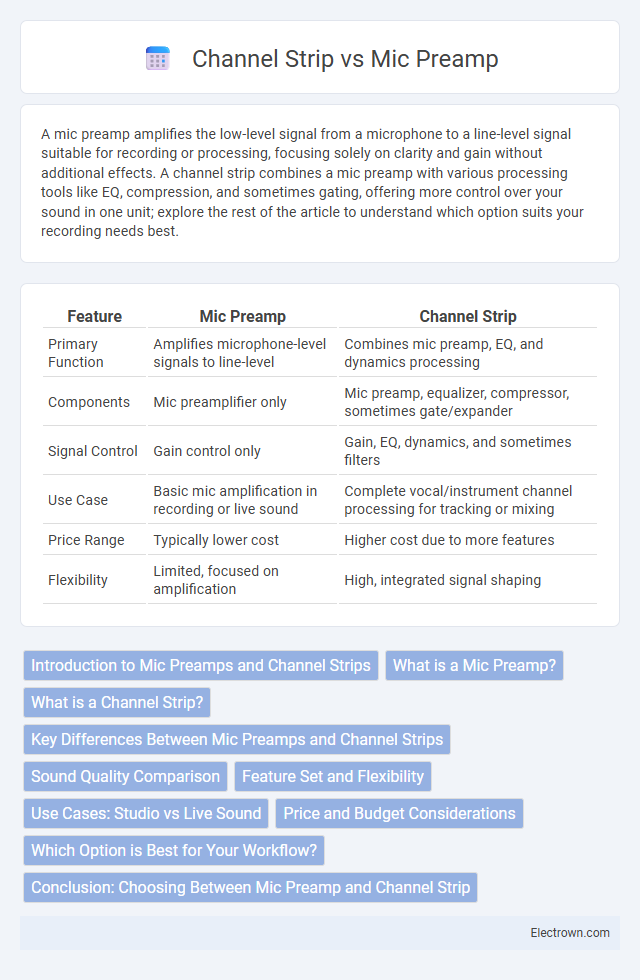A mic preamp amplifies the low-level signal from a microphone to a line-level signal suitable for recording or processing, focusing solely on clarity and gain without additional effects. A channel strip combines a mic preamp with various processing tools like EQ, compression, and sometimes gating, offering more control over your sound in one unit; explore the rest of the article to understand which option suits your recording needs best.
Table of Comparison
| Feature | Mic Preamp | Channel Strip |
|---|---|---|
| Primary Function | Amplifies microphone-level signals to line-level | Combines mic preamp, EQ, and dynamics processing |
| Components | Mic preamplifier only | Mic preamp, equalizer, compressor, sometimes gate/expander |
| Signal Control | Gain control only | Gain, EQ, dynamics, and sometimes filters |
| Use Case | Basic mic amplification in recording or live sound | Complete vocal/instrument channel processing for tracking or mixing |
| Price Range | Typically lower cost | Higher cost due to more features |
| Flexibility | Limited, focused on amplification | High, integrated signal shaping |
Introduction to Mic Preamps and Channel Strips
Mic preamps amplify low-level microphone signals to line level, enhancing audio clarity and gain control. Channel strips combine a mic preamp with additional processing tools like EQ, compression, and sometimes gating, offering an all-in-one solution for shaping sound. Understanding the core function of mic preamps versus the integrated workflow of channel strips helps in choosing the right equipment for professional audio recording and mixing.
What is a Mic Preamp?
A mic preamp is an essential audio device that amplifies the low-level signal from a microphone to a line-level signal suitable for further processing and recording. It enhances sound quality by adding clarity, warmth, and gain, ensuring the microphone signal is strong and free of noise. Mic preamps can be standalone units or integrated into audio interfaces, mixers, and channel strips, each varying in features and tonal characteristics.
What is a Channel Strip?
A channel strip combines a microphone preamp with additional processing tools such as equalization, compression, and sometimes gating in a single unit, streamlining audio signal control. Unlike a standalone mic preamp that solely amplifies low-level microphone signals to line level, a channel strip offers versatile tone shaping and dynamic control options, making it ideal for recording and live sound applications. This integration improves workflow efficiency while maintaining high audio fidelity in professional studio environments.
Key Differences Between Mic Preamps and Channel Strips
Mic preamps primarily amplify low-level microphone signals to line level, enhancing clarity and detail without adding significant effects. Channel strips combine a mic preamp with additional processing modules such as equalizers, compressors, and filters, providing more control and customization over the audio signal. The key difference lies in functionality: mic preamps focus on amplification quality, while channel strips offer integrated signal shaping and dynamic control.
Sound Quality Comparison
Mic preamps focus solely on amplifying the microphone signal, delivering clean and transparent sound with minimal coloration, which is essential for capturing the purest audio. Channel strips combine a mic preamp with additional processing tools like EQ and compression, often adding character or color that can enhance or alter the tonal quality. Your choice depends on whether you prefer the uncolored fidelity of a dedicated mic preamp or the sculpted, versatile sound shaping offered by a channel strip.
Feature Set and Flexibility
Mic preamps primarily focus on amplifying microphone signals with high gain and low noise, offering limited additional processing features. Channel strips combine a mic preamp with EQ, compression, and sometimes gating or de-essing, providing greater flexibility for shaping sound directly on the unit. This integrated feature set makes channel strips ideal for streamlined recording workflows and on-the-fly tonal adjustments.
Use Cases: Studio vs Live Sound
Microphone preamps are essential in both studio and live sound environments for amplifying low-level mic signals to line level, offering clean gain and minimal noise. Channel strips combine a mic preamp with EQ, compression, and other processing, making them ideal for live sound engineers who need quick and comprehensive tone shaping on stage. Studios often prefer standalone mic preamps for high-quality signal capture, while live sound setups benefit from channel strips' integrated features for efficient workflow and consistent sound control.
Price and Budget Considerations
Mic preamps typically cost less than channel strips, making them a budget-friendly choice for those focused solely on clean amplification of microphone signals. Channel strips combine a mic preamp with additional processing tools like EQ and compression, resulting in a higher price but offering more versatility within a single unit. Your choice depends on whether you prioritize affordability or an all-in-one solution for recording and mixing.
Which Option is Best for Your Workflow?
Choosing between a mic preamp and a channel strip depends on your workflow preferences and recording needs. A mic preamp excels at providing clean, high-quality gain for microphones, making it ideal for users seeking straightforward amplification without extra processing. Channel strips integrate preamps with EQ and compression, offering a streamlined solution for those who want to shape and control their sound within a single unit, optimizing setup and saving time during tracking.
Conclusion: Choosing Between Mic Preamp and Channel Strip
Choosing between a mic preamp and a channel strip depends on the specific needs of your audio setup and workflow. Mic preamps primarily amplify low-level microphone signals with clarity and minimal noise, ideal for pure gain stages. Channel strips combine mic preamps with EQ, compression, and sometimes gating to provide a versatile all-in-one solution for shaping and controlling audio signals in recording or live sound environments.
mic preamp vs channel strip Infographic

 electrown.com
electrown.com